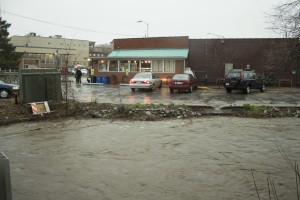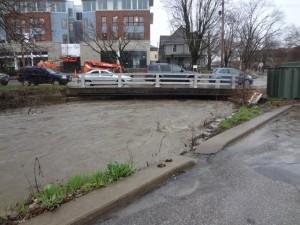Today’s rain in Eastern Iowa has been incessant and the forecast calls for more. Iowa City has been especially hard-hit, with New Pioneer Food Co-op documenting the rising Ralston Creek near the store. I’ve been hearing that Solon is looking for volunteers to help sand bag, as well.
Here is more from the National Weather Service:
The National Weather Service in the Quad Cities has issued a Flash Flood Warning for Iowa County in east central Iowa. Johnson County in east central Iowa. This includes the City of Iowa City and Coralville. Keokuk County in southeast Iowa. This includes the city of Sigourney. Northern Washington County in southeast Iowa.
- Until 5:30 pm CDT.
- At 11:27 am CDT, local law enforcement officials reported flash flooding from a thunderstorm over the warned area.
- Locations In the warning include but are not limited to University Heights, Tiffin, Solon, Oxford, Oakdale, North Liberty, Lake Macbride State Park, hills, Coralville, Williamsburg. Parnell, North English and Millersburg.

New Pioneer Food Co-op is shown behind a rising Ralston Creek on Wednesday, April 17, 2013. Officials have declared a flash flood warning in Eastern Iowa. (photo/New Pioneer Food Co-op)
Recommended actions
Additional rainfall of 1 to 2 inches is expected this afternoon. Flooding of small streams and creeks, highways and streets. Underpasses and low lying urban and rural areas is likely.
Excerpted from ready.gov Before:
- Build an emergency kit and make a family communications plan.
- Elevate the furnace, water heater and electric panel in your home if you live in an area that has a high flood risk.
- Consider installing “check valves” to prevent flood water from backing up into the drains of your home.
- If feasible, construct barriers to stop floodwater from entering the building and seal walls in basements with waterproofing compounds.
- More about:
- What to do before a flood.
During:
- Be aware that flash flooding can occur. If there is any possibility of a flash flood, move immediately to higher ground. Do not wait for instructions to move.
- If you must prepare to evacuate, you should do the following:
- Turn off utilities at the main switches or valves if instructed to do so. Disconnect electrical appliances. Do not touch electrical equipment if you are wet or standing in water.
- Secure your home. If you have time, bring in outdoor furniture. Move essential items to an upper floor.
- Be aware of stream, drainage channels, canyons and other areas known to flood suddenly. Flash floods can occur in these areas with or without typical warnings such as rain clouds or heavy rain.
- If you have to leave your home, remember these evacuation tips:
- Do not walk through moving water. Six inches of moving water can make you fall. If you have to walk in water, walk where the water is not moving. Use a stick to check the firmness of the ground in front of you.
- Do not drive into flooded areas. If floodwaters rise around your car, abandon the car and move to higher ground if you can do so safely. You and the vehicle can be swept away quickly.
- Do not camp or park your vehicle along streams, rivers or creeks, particularly during threatening conditions.
- More about:
- What to do during a flood.
What is a Flash Flood Warning?
StatementWatchWarning
This warning signifies a short duration of intense flooding of counties, communities, streams, or urban areas with high peak rate of flow. Flash floods may result from such things as torrential downpours, dam breaks, or ice jam breaks. They are issued by the local National Weather Service Office for 4 hours or less. Since flash flooding can occur in severe thunderstorms, this type of warning can be combined with either a Tornado Warning or a Severe Thunderstorm Warning. Source: srh.noaa.gov


No Comments Yet